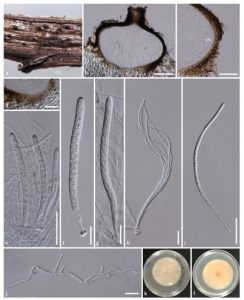Pseudoophiobolus italicus Phookamsak, Wanas., Camporesi & K.D. Hyde, sp. nov. Index Fungorum number: IF553926
Etymology: The specifific epithet ‘‘italicus’’ refers to the country Italy, where the species was collected
Holotype: MFLU 17-0932
Saprobic on Onobrychis viciifolia Scop. Sexual morph: Ascomata 220–300 µm high (excluding papilla), 290–380 µm diam., black, scattered, solitary to gregarious, semi-immersed to erumpent, globose to subglobose, uniloculate, glabrous, covered by loose hyphae, ostiolate, papillate. Papilla 80–130 lm high, 100–115 lm diam. mammiform to oblong, with truncate apex, short papillate, composed of several layers of small, thick-walled, dark brown to black, pseudoparenchymatous cells, arranged in a textura angularis, ostiole central, opening pore-like, with hyaline periphyses. Peridium 10–40 lm wide, slightly thick at the base, composed of several cell layers of flattened, dark brown to black pseudoparenchymatous cells, arranged in textura angularis to textura prismatica. Hamathecium composed of dense, 1.5–3.5 lm wide, filamentous, cellular pseudoparaphyses, indistinctly septate, slightly constricted at the septa, anastomosing at the apex, embedded in a hyaline gelatinous matrix. Asci (132–)140–160(–164) x (7–)8–10 lm (x = 149.9 x 8.7 µm, n = 30), 8-spored, bitunicate, fifissitunicate, cylindrical, short pedicellate, with furcate to truncate pedicel, apically rounded, with indistinct ocular chamber. Ascospores (112–)120–150(–163) x 2–3.5 µm (x = 139.2 x 2.9 µm,n = 30), fasciculate, scolecosporous, hyaline to subhyaline, becoming yellowish at maturity, fifiliform, with rounded ends, tapered towards the lower cells, swollen at the 6th cell, near the basal septum, 14–15-septate, indistinctly septate, not constricted at the septa, smooth-walled. Asexual morph: Undetermined.
Culture characteristics: Colonies on PDA reaching 33–35 mm diam. after 4 weeks at 25–30 C, medium dense, irregular, flflattened, surface smooth, with edge undulate, slightly radiating at the margin, velvety to woolly, colony from above, pale orange-yellowish at the magin, pale yellowish-grey at the centre, margin separated from the middle part by pale grey concentric ring, colony from below, yellowish-brown at the margin, white to cream edge, dark yellowish to brown at the centre, paler towards the inward secter, with dark brown concentric ring, not producing pigmentation in agar.
Material examined: ITALY, Province of Trento [TN]), near Mezzana—Valdisole, on dead stem of Onobrychis viciifolia Scop. (Fabaceae), 5 August 2014, E. Camporesi, IT 2023-w (MFLU 17-0932, holotype), ex-type living culture, KUMCC 17-0167 = MFLUCC 17-2255.
Notes: Pseudoophiobolus italicus resembles P. subhyalinisporus in the ascospores being hyaline to pale yellowish and swollen at the 6th cell near the basal septum. However, P. italicus has larger ascospores with more septa (Table 3). Multigene phylogenetic analyses also provide further evidence to justify our new species as it segregates from P. mathieui with high support. (100% ML, 100% MP and 1.00 PP)
Hosts: Onobrychis viciifolia Scop. (Fabaceae)
Distribution: Italy
FIG 10 Pseudoophiobolus italicus (MFLU 17-0932, holotype). a Appearance of ascomata on the host surface. b Section through ascoma. c, d Section through peridium. e Asci embedded in cellular pseudoparaphyses. f, g Asci. h, i Ascospores. j Germinating ascospore. k, l Culture characteristics (k = from above, l = from below). Scale bars: b = 100 µm, c–e = 50 µm, f–j = 20 µm

